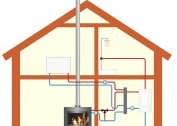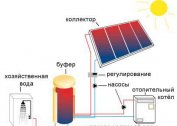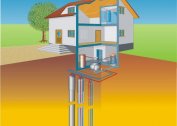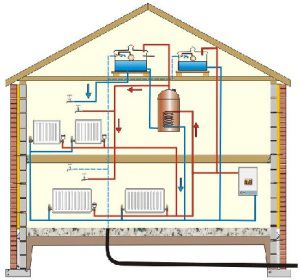
The most suitable for heating private homes are deservedly considered radiator heating systems, the experience of which demonstrates their excellent performance. They perform their functions without fail, while remaining simple and easy to operate. The question of the device in the house of radiator heating with their own hands worries many owners of private housing. Our article is intended to inform readers about how to design and install such heating systems.
Features of radiator heating at home
Compared to other types of heating, radiator systems require less energy to heat rooms. Accordingly, the financial costs of their installation and maintenance will also be relatively small. A water boiler can be chosen that uses the most available fuel in the region (gas, peat, coal). Making DIY pipe routing for radiator heating is much easier than, for example, installing a “warm floor” system. Radiators are easy to install in every room where they will warm the air, saturating it with heat from the hot water circulating in the system.
For heating homes, radiator heating is used, the scheme of which provides one of two ways to move the coolant through pipes:
- through natural circulation, when hot water displaces cooled water back into the boiler with its increased pressure;
- by artificial circulation, when the circulation pump pumps pressure and enhances the movement of the coolant.
The system can be made self-regulating if thermostatic valves are installed during the installation of radiator heating. The distribution of heat fluxes around the house will occur automatically, depending on the temperature needs of each room.
The use of radiator radiators also has its drawbacks. The heated air constantly circulates around the room, and dust flies with it, which creates some discomfort. In addition, certain areas in the room remain insufficiently heated. But such inconveniences are almost imperceptible against the background of the undoubted advantages of the heating system we are considering.
Schemes of radiator heating networks
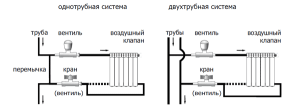
Depending on the method of connecting pipes to the heating devices, radiator heating of a country house can be performed in the form of the following schemes:
- Single tube - heating devices are connected in series, and the coolant flows through each radiator heating battery, heading to the next. In this case, the last of the batteries heats less than the previous ones;
- Double pipe - hot water is supplied to each radiator in one pipe, and the cooled leaves in another. All batteries with a parallel connection receive the same share of thermal energy;
- Collector - It has a more convenient adjustment of the system and heat distribution. The total pipe length with this scheme is significantly increased.
Some users consider a single-tube radiator heating system to be ineffective, because there is no way to regulate the heating of each radiator individually.But to fix this situation, the installation of a bypass, an additional jumper with a temperature controller, which is placed near the heating device, will help.
Using a one-pipe system, it is possible to reduce costs by 25%, compared with a two-pipe, due to a more rational laying of pipes.
The use of a collector for radiator heating helps to solve the problem of uniform heating of all rooms of a large cottage. This device optimizes system performance and reduces heat loss. True, the collector system can operate only in conditions of forced circulation, and its construction requires the laying of numerous pipelines.
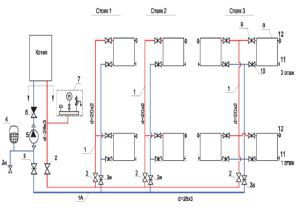
Heating devices are connected in different ways to the heat supply line. For example, a radiator heating scheme for a two-story house can be made with connection to a vertical riser. Hot water is supplied from the boiler to a vertical riser, and then bred to radiators. The coolant can be supplied to the riser both from below and from above.
Horizontal connection options are more convenient to use in buildings with large areas. The pipelines located at the floor level are connected to the bottom of the radiators, and this scheme allows you to hide the pipes under the decorative lining.
The efficiency of the coolant circulation in long horizontal lines should be ensured by the use of a circulation pump.
Types of heating equipment
The main set of equipment for radiator heating of a country house consists of a heating boiler, pipelines and heat exchangers (radiators). If necessary, the system can be supplemented with a circulation pump, a collector, an expansion tank, bypasses and temperature regulators.
Heating boiler
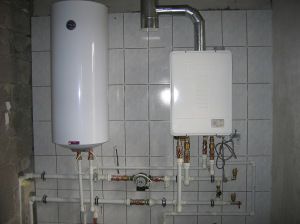
The most economical source of heat can be considered a gas-fired boiler. A variety of models of these heating devices makes it possible to use them in any of the radiator heating circuits. The most powerful units must be installed on the floor in special rooms, and compact gas boilers can be hung on the wall in the kitchen or utility room. To install gas heating devices in the house, it is necessary to obtain a permit, and only a specialist has the right to mount them. An electric heating boiler can be equipped with a safety group, automation, a built-in pump, an expansion tank and other useful devices. Using it in a radiator heating system is quite convenient, but very unprofitable due to the high cost of paying for electricity.
The solid fuel boiler is an old proven heat source, improved by new technologies. Some difficulties in the installation of radiator heating may occur due to the fact that it is undesirable to use plastic pipes in the boiler circuit of a solid fuel boiler.
Pipe material

Steel pipes - heavy and susceptible to corrosion - are everywhere replaced by more practical metal-plastic and polypropylene. There is an option to use copper pipes, but due to the high cost, such a heating system will not be affordable for everyone.
For the installation of metal-plastic pipes, bulky welding equipment is not needed. Reliable joints are made using crimp fittings or press fittings using flaring and pressing tools. Not only a piping system is made of metal plastic, but also collectors for radiator heating.
Polypropylene pipes and corresponding fittings for them are even more affordable than metal-plastic ones. For independent work with them, you will need to purchase a special soldering iron for polypropylene pipes. With proper use in a home heating system, this material will last a long time. The polypropylene pipe does not burst even if the system is defrosted accidentally.
The choice of radiators for heating
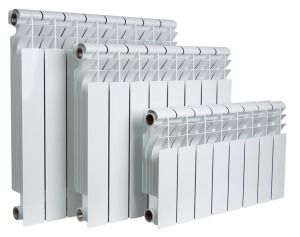
Modern radiator radiators are made of metals with different properties. Consider their features:
- Aluminum - light and compact, they provide high heat dissipation due to additional internal ribs. The thermal conductivity of aluminum is so great that the battery heats up in minutes. Among the shortcomings are sensitivity to the pH of the coolant and the fragility of threaded connections;
- Bimetallic - more reliable due to the presence of steel tubes in the aluminum case. They have high chemical resistance and withstand high blood pressure. Their benefits are better manifested in systems with forced circulation;
- Steel - are made of two steel plates connected into a single panel. Thanks to stamped recesses, they have high heat dissipation. A variety of dimensions of panel radiators makes it easy for customers to choose;
- Cast iron - unlike their Soviet predecessors, they are more attractive in design and have improved characteristics.
The choice of a specific radiator model should be made taking into account all the features of a home heating system.
When calculating the power of heating radiators, keep in mind that if they are covered with decorative shields, heat transfer can be reduced by 10%.
DIY radiator heating installation

The main thing is that the scheme of the radiator heating device should be thought out, without which it is impossible to start work. It is convenient to make a preliminary calculation of the system using the online calculator, but only a heating engineer can calculate the heating performance more accurately. Its services must be used to insure against errors in the calculations.
Do-it-yourself radiator heating must be installed in a certain sequence:
- Install the boiler in the room intended for it.
- Bind the boiler (preferably, under the supervision of a specialist).
- Mount the collector for radiator heating (if applicable).
- Route the pipes and (if necessary) install a circulation pump.
- Attach radiator batteries to the brackets in designated areas.
- Connect the piping to the radiators.
- Test and test the system.
A specific option for laying pipes for radiator heating in a country house is chosen based on the interior design project. Pipelines are laid along the walls or hidden in gates. With hidden pipe laying, it will be necessary to insulate. In the radiator heating scheme of a private two-story house, a warm floor can also be present. In this case, it is permissible to screed the floor with the pipes laid inside it only after crimping the system.
To prevent the formation of air jams, in a system with natural circulation, it is necessary to lay horizontal pipes with a slope in the direction of flow of the coolant. The slope should be 10 mm per meter of pipe length.
Radiators are connected to the pipeline in three different ways:
- diagonal connection - the coolant enters through the upper pipe on one side of the radiator, and exits through the lower pipe on the other side;
- lateral one-sided - supply and removal of the coolant is carried out only on one side;
- bottom connection - the coolant enters and exits through the two lower nozzles.
The video shows how to install an aluminum radiator battery:
Own installation of radiator heating in your home gives a thrifty owner the opportunity to save. But besides financial gain, moral satisfaction from the work done is also important. As a result, not only the microclimate will become warm, but also warm lights will appear in the eyes of households.
